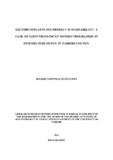| dc.description.abstract | The purpose of this study was to investigate the influence of project management
capacity, community development structures and participation on project sustainability for
projects under SFIC programme in Otiende Subcounty in Nairobi County Kenya. The problem
was to establish whether community project maangemnt capacity, development structures and
participation had influence on community development sustainability. The objectives of the
study were; to determine the influence of management capacity on project sustainability; to
assess the influence of community development structures on project sustainability; to
determine the influence of community participation on sustainability. The research questions
the study sought to answer were; to what extent does community project maangemnt capcity
influence project sustainability; how do community development structures influennces project
sustainability and lastly to what extent does community participation influences project
sustainability. Three bodies of theories namely asset based community development, system
and sustainability theories provided frameworks for the study. Descriptive design was adopted.
The target population was 1800 people where a sample of 90 respodents was drawn from
accessible population of 900 people through simple random sampling. The accessible
population of 900 and a sample size of 90 respodents was drawn according to Fisher’s and
Mugenda’s recommendation of 50% and 10% for acess population and sample drawn from
target and acess population respectively. The reliability of the research instrument was
determined by piloting with 1% of the accessible population questionnaires analysis using
Split- half test where reliability coefficient was r= 0.7944 indicating relatively high reliability.
Descriptive, correlations and cross tabulation was adopted for data analysis using SPSS. The
revelation of the study is that project management capacity to some extent influence project
sustainability. This is indicated by positive correlation between respondents indicating having
x
contributed resources to project, respondents indicating their direct responsibility in raising
resources and rating of community leadership at r=0.87. Community development structures
factors such as experience and capacity to sustain project influences sustainability. Rating of
CBOs structures in terms of sustaining projects and age of the CBOs correlate positively at r=
1.0. Community participation to some extent was found to influence project sustainability. This
is indicated by respondents having been trained by the development agencies and number of
partners identified indicated by a fair positive correlation of r=0.214. Finally on project
sustainability indicators, resources contribution by the respondents, age of the projects and
community capacity to identify additional partners were revealed as key indicators for project
sustainability. The study recommend that in future, development agencies may consider giving
priority to developing capacity in community leadership, training, work with the existing
CBOs and create awareness on the community role and responsibility on their own
development agenda. Finally it is suggested that further studies may be consifered for
inferentially establish how and why on positive and negative correlations between project
management capacity, community development structures and participation with project
sustainability indicators. | en_US |

